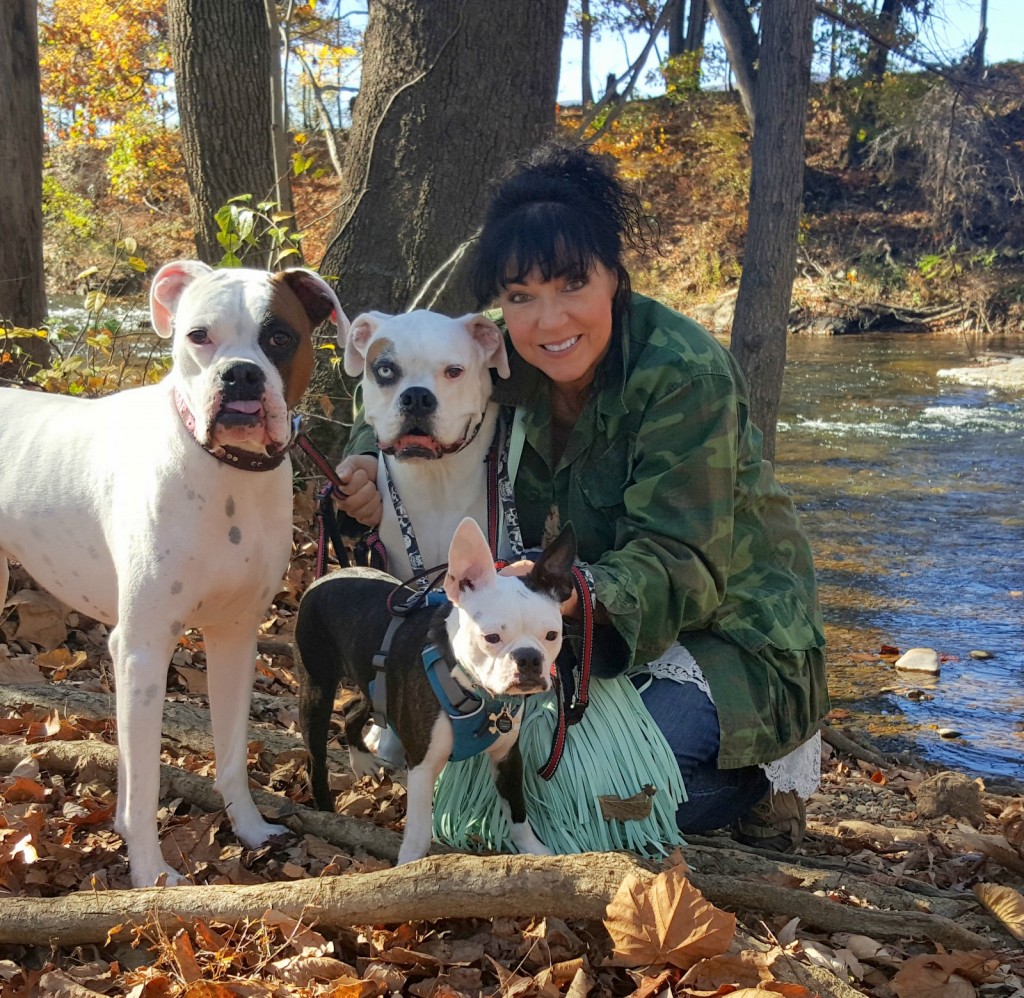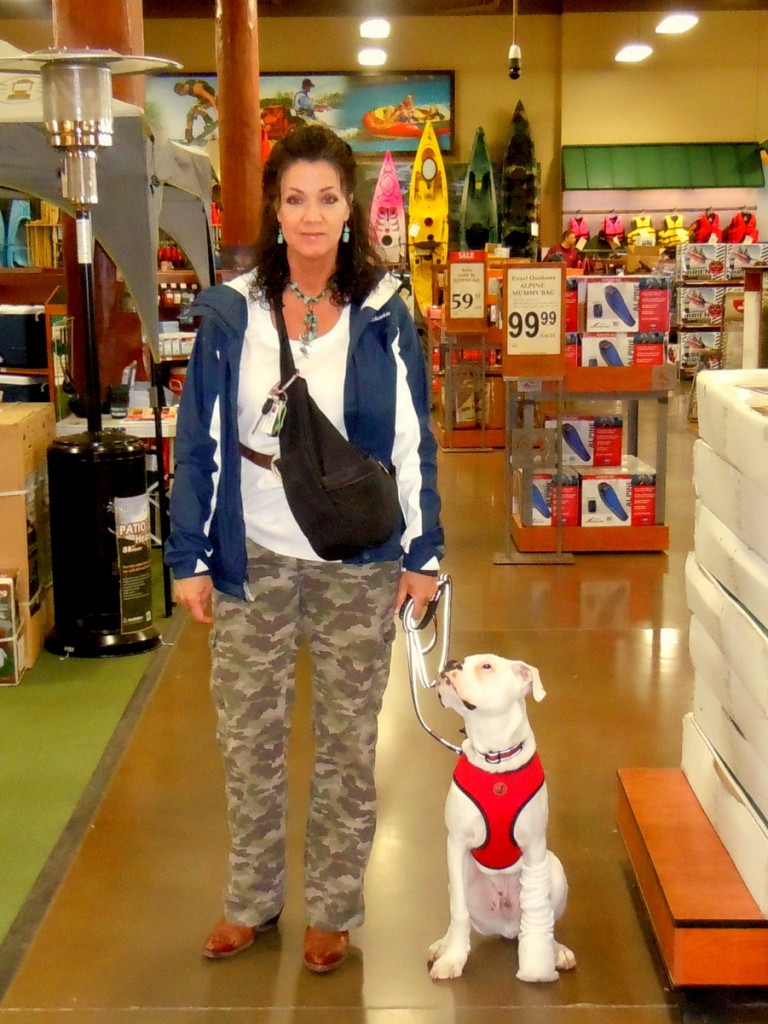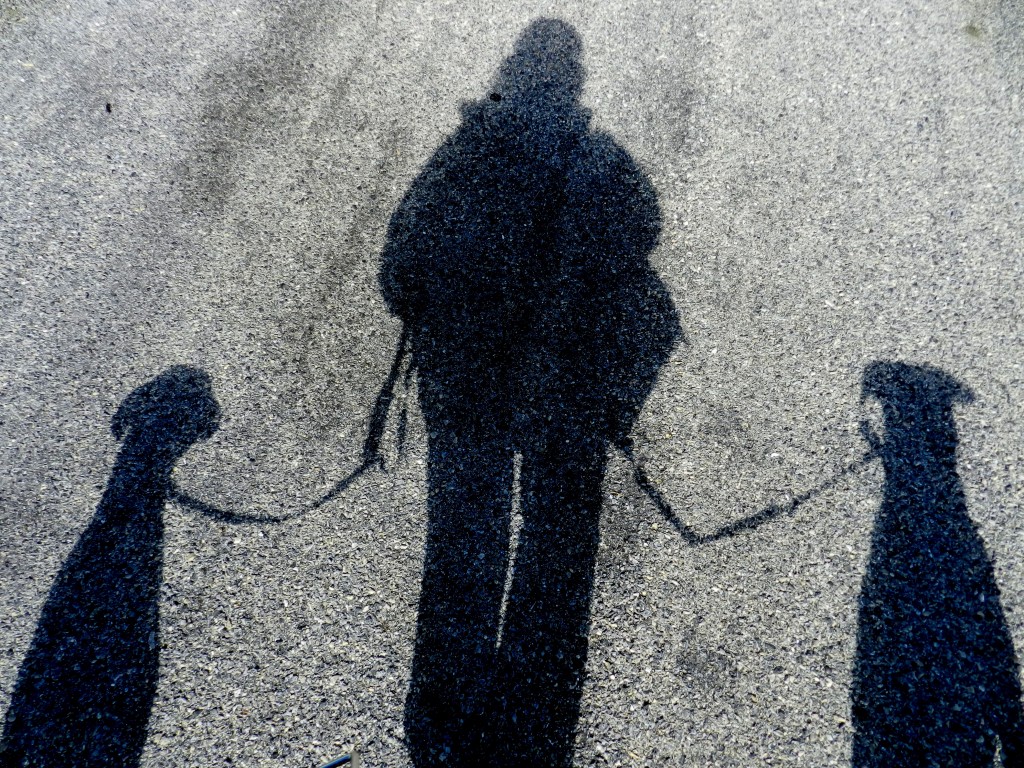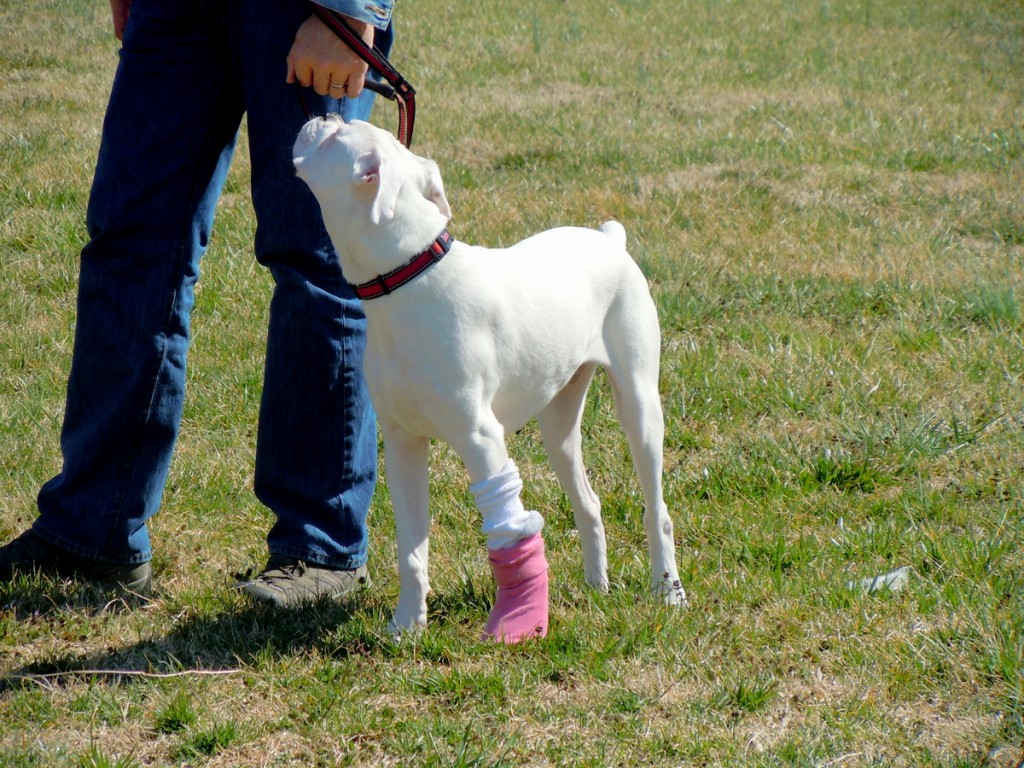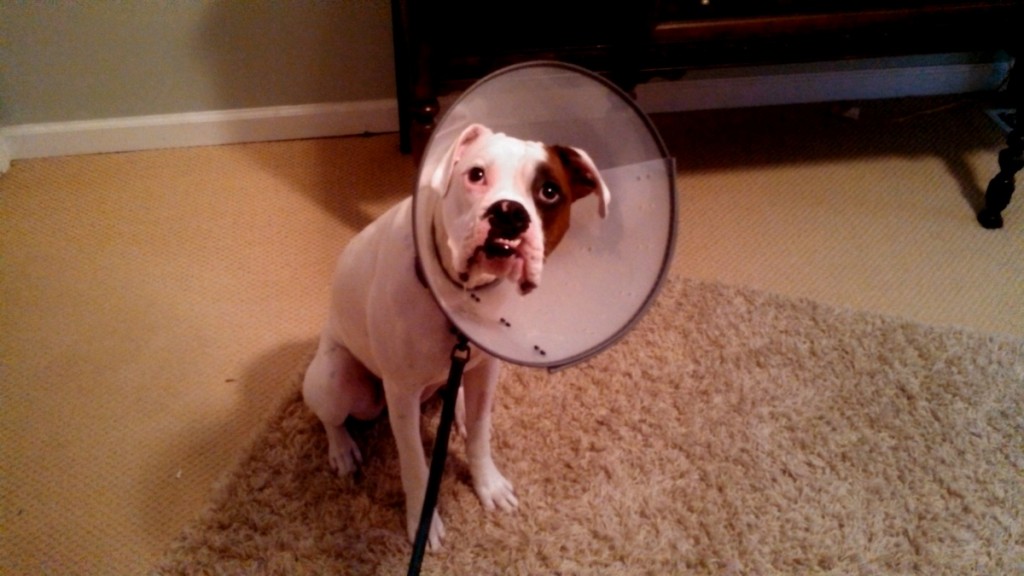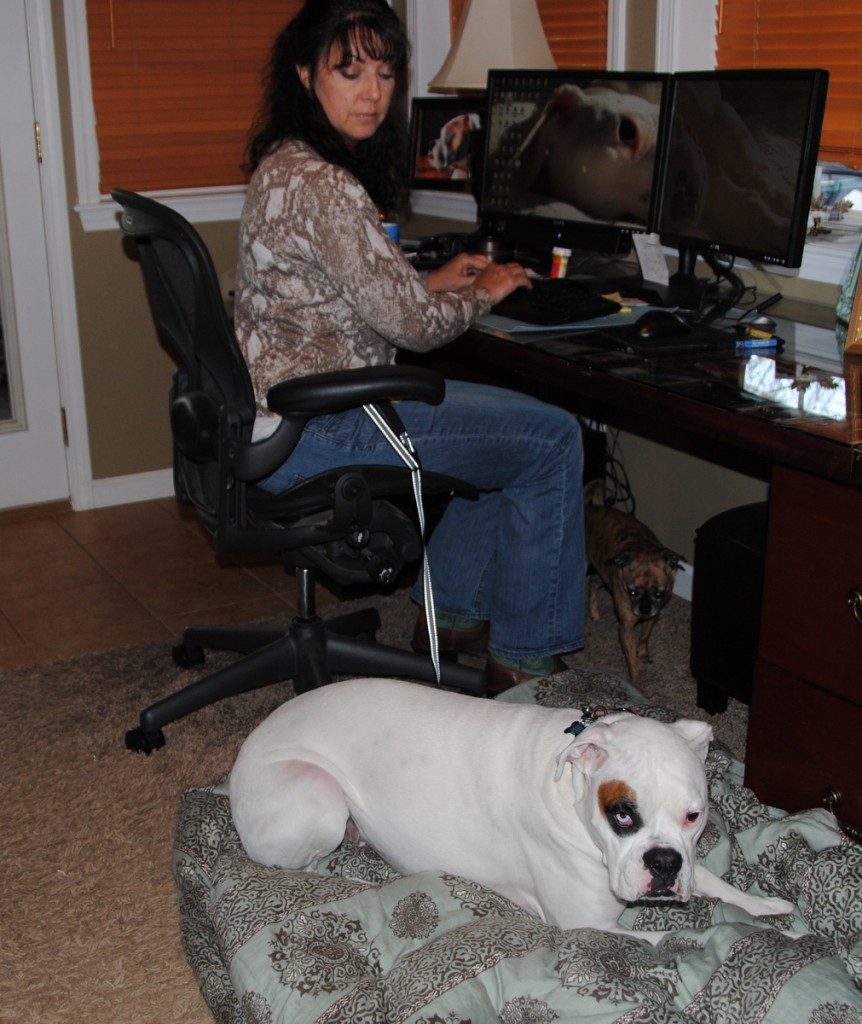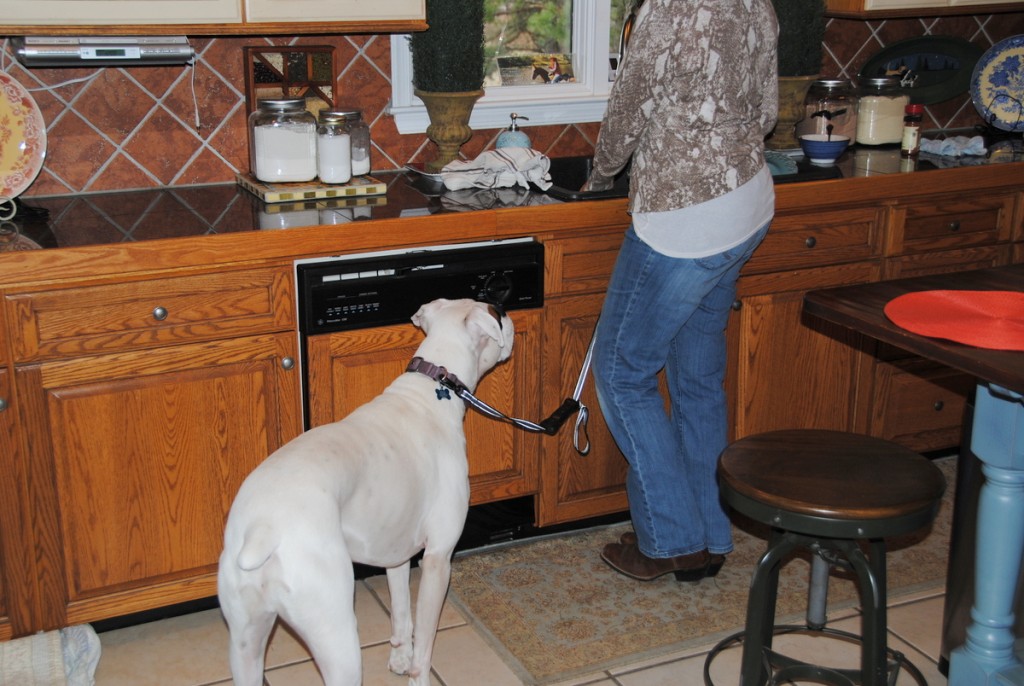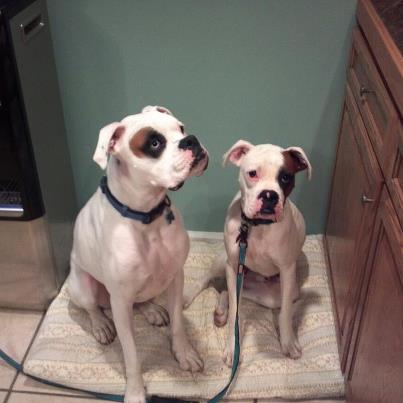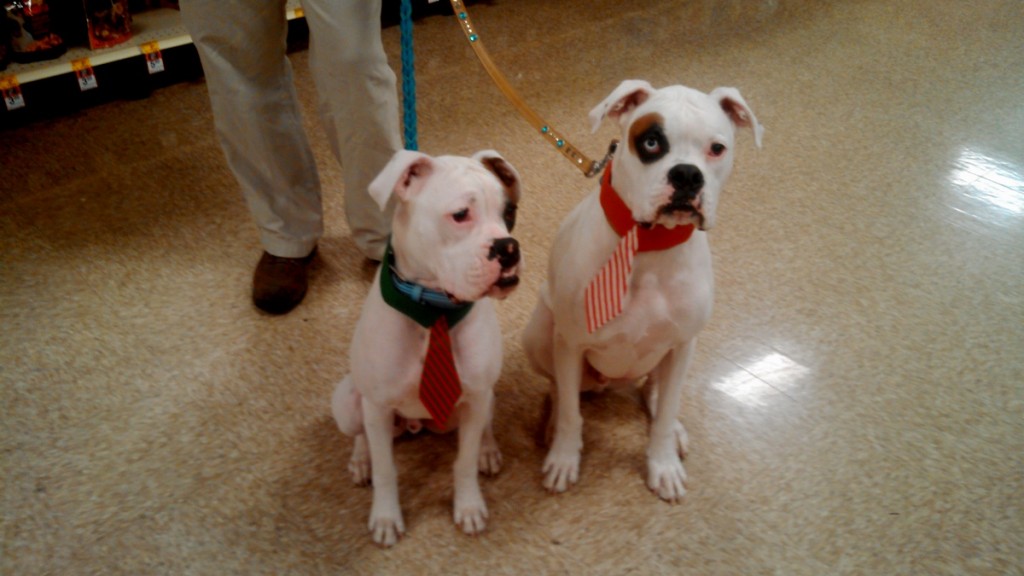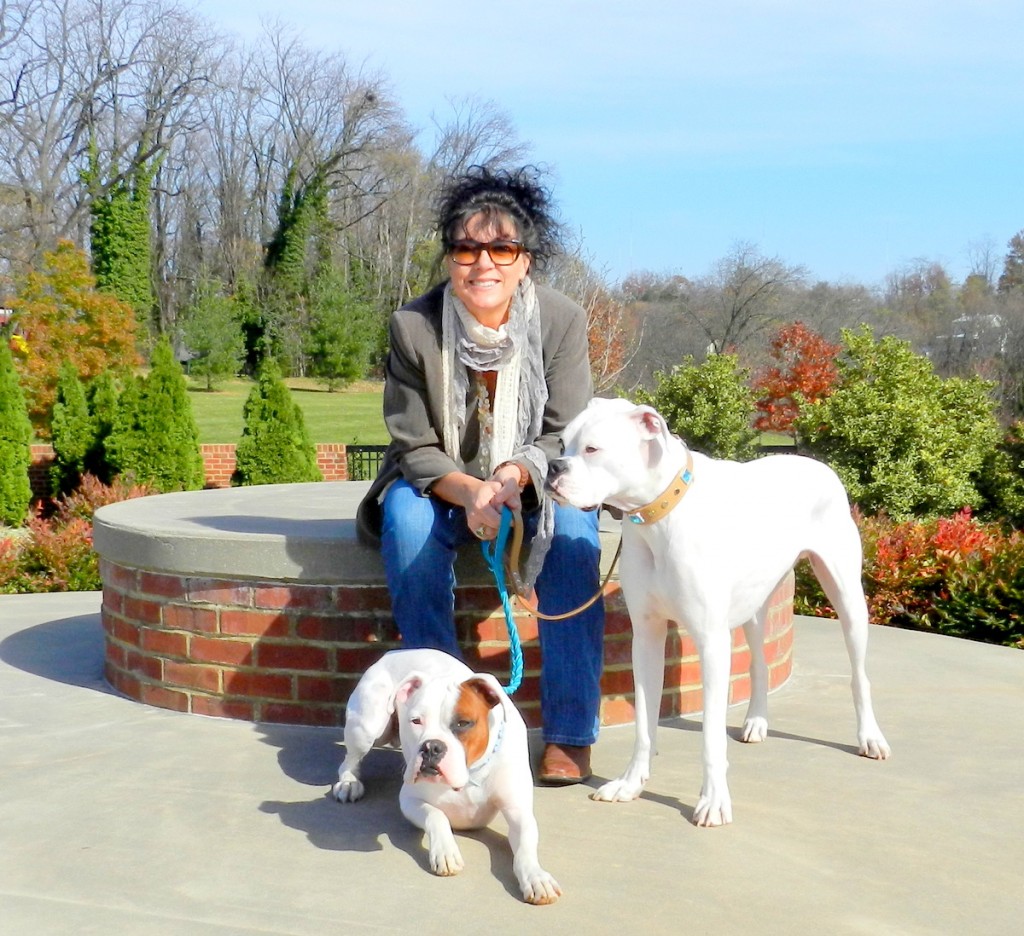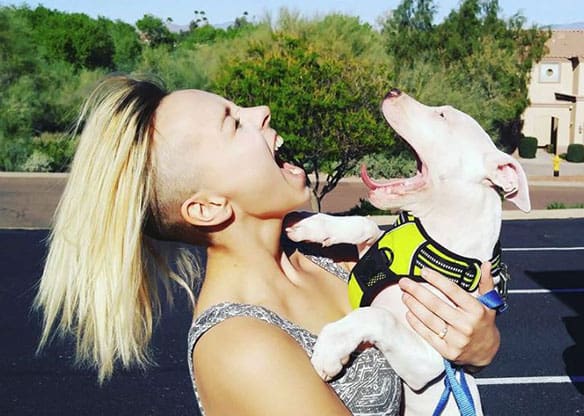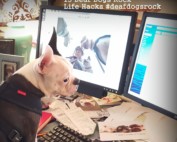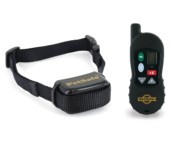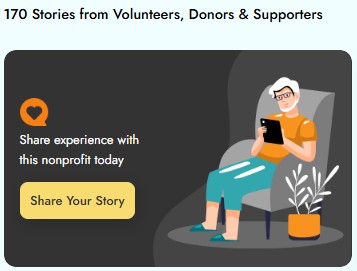Tether Training Your Deaf Dogs by Christina Lee – Deaf Dogs Rock
I personally think directional training is everything when you live with a deaf dog and for this reason I want to tell you all about tether training.
All three of my deaf dogs Nitro, Bud, and Bowie are tether trained. When I point at the back door all three deaf dogs meet me there.
Tethering training is clipping one end of a leash to your dog and the other end of the leash to your belt. This training is great for deaf and hearing dogs alike because by consistently pointing and signing while a deaf dog is clipped to you will make life so much enjoyable in the future when you can just point left and your deaf dog goes left, or you can point right and your deaf dog goes right. A good example of successful tether training is when you point at the back door and your deaf dog meets you at the back door. Doing tether training and not doing tether training can make the difference between just pointing and your deaf dog automatically goes where you point or feeling like you are herding cats all the time because you did not take the time to do tether training (trust me herding your deaf dog all the time will wear you out). Chris and I did a lot of tether training when Nitro was a puppy not because we ever read about it but it was because we did it out of necessity to keep Nitro safe.
When Nitro was around five months old he had an accident and broke his toe. He was goofing around running fast down a hill in our muddy back yard and when he turned he wiped out and hyperextended his front leg and wiped out. He literally slid down the muddy hill and broke his toe on his front left paw. When he came to the back door holding his paw up and he wouldn’t put weight on it I knew something was terribly wrong. I was beside myself! Chris and I rushed him to the Vet for X-Rays. Poor little Nitro had to wear a splint on his front leg and then be tethered to me for several weeks so he would not run or jump.
In the included photos, you’ll see me using a Kong Control Grip leash, which appears to be discontinued. What is key is that you have a leash with a clipping handle, this allows you to attach the leash to your belt/waist easily. Our current recommendation is the [easyazon_link identifier=”B01MR5LOFQ” locale=”US” tag=”deafdogsrock-20″]Ruffwear Flat Out leash[/easyazon_link] which has a nice simple to release buckle on the handle.
[easyazon_infoblock align=”center” identifier=”B01MR5LOFQ” locale=”US” tag=”deafdogsrock-20″]Even though I was in “puppy jail” with Nitro, I can’t begin to tell you how valuable tethering him to me was for our bonding and training. When I first tethered him to me, I made sure to use sign cues and directional pointing when I would get up and go from room to room or turn in a certain direction. Directional training a deaf dog is very important for a deaf dog to learn. Unless of course you want to get up, stop what ever you are doing at the time, go get your dog, and guide him to where ever you want him to go. I don’t know about you but with 6 dogs I don’t have that much energy to be chasing around two deaf dogs and guiding them where I want them to go. I like to be able to just point and they go where I point. This can make life so much easier for you and your deaf dog not to mention you won’t get so frustrated once your deaf dog gets good at navigating their directional training signals.
Another great thing about tether training is your sign training. Be sure to take a look and try to memorize many of the signs you will be using on your dog when you are tether training. Try to also use everyday sign cues like “time to eat”, “do you want water?” or “time to go for a ride” for example.
To check out some of the signs you will use during your tether training, click here to look at our “Beginning Sign Training” post on DeafDogsRock.com
Photo above: Nitro looking up at me (Christina Lee) for direction in Gander Mountain- notice his little leg splint?
After Nitro had been tethered to me for a while, all I would have to do is point in a certain direction and he would automatically go there. I made sure to carry small treats in my pocket so whenever he made eye contact with me, I would open flash my hand (instead of the sound of a clicker) to mark his good behavior and then give him treat. What this positive reinforcement “watch me” training did is condition Nitro to check in with me often.
When out for a walk if Nitro decided to pull me in one direction, I would immediately go the opposite direction. He learned very fast that if he wanted to get somewhere, pulling was not a good option for him to choose. His reward for not pulling me in a certain direction was to continue to walk in the direction he wanted to walk in as a reward for not pulling. He learned to wait for me to give him direction. I always make an effort to get my young dogs and our deaf foster dogs out in public. My goal is to take them as many places as I can to get them socialized. As you can see from the photo below, when I have both of my deaf dogs out walking with me(they are tethered to my cross body bag), they both loose leash walk because of all the tether training they received when they were young.
Even though Nitro and I had 8 long weeks attached to each other by a leash, what I didn’t realize at the time was just how much tether training would benefit his loose leash walking. Nitro has turned out to be the best loose leash walker dog I have ever had. Now he watches my body language and follows my lead and very rarely ever pulls me which I love! Tether training should only be done for a short term (like a week or two with breaks in between) because you don’t want to set you dog up for developing Separation Anxiety. If you need him to be near you consider looking at Tips to Pet Proof Your Home.
Another good tip on loose leash walking: If you have a deaf dog that pulls a lot, then I recommend changing direction every single time he/she pulls on the leash. You will go in circles for awhile because when you change your direction your dog will pull in the opposite direction until he figures out what is going on. What you will discover is after a few times of turning around in a circle your dog will take a deep breath, look up at you, and you will reward the dog for “checking in” and not pulling you by continuing in the direction you are going. If after a few minutes of going in the direction he wants as a reward, he starts to pull again, change direction again. Be sure you repeat, repeat, repeat! Remember the reward for not pulling and checking in with you is to continue to go in the direction he/she wants to go. You will see your deaf dog’s wheels start to turn and a light bulb in his brain will come on when he figures out what you are doing. If he checks in often with you, give him a “thumbs up” sign, a smile and a treat. If you can get him to check in often, be sure to mix it up his routine a bit and add a “sit” and a “wait”, then give the thumbs up, and a treat. To come out of a sit and wait and continue to walk forward give the “forward” cue to let the dog know you are releasing him from the sit and wait.
Photo above: Nitro looking up at his daddy for direction and eye contact
Since I had such a great experience tether training Nitro, I decided when I brought our deaf foster dog Bud home after his neuter surgery, I would do the same tether training with Bud. The big difference with Bud was when he got here to our farm at eleven months of age he had rarely ever been on a leash. I knew I had my work cut out for me. Before I started tether training on Bud I got him comfortable with the leash by taking him out often to go potty with a six foot leash connected to his collar. I recommend getting the dog used to the leash first before you try tether training on your deaf dog. My ultimate goal with tethering Bud was to make sure he didn’t run and play while recovering from his neuter surgery. I also wanted to jump start his new sign training and directional training. He seemed to follow my lead, make eye contact often, and go in the direction I pointed.
Photo above: Bud with his cone of shame after surgery.
After the first week of Bud being tethered to me he became very comfortable with loose leash walking. He also started paying very close attention to me and my body language as well as learning new signs every day. To this day out of all six of my dogs (hearing and deaf) Bud follows my direction pointing better then any dog that currently living with us. If I pat my knee and sign “come” he drops whatever he is doing and dashes right over to my side. If I point for Bud to go in a certain direction in the house he goes.
Photo above: Make sure you have a comfortable place for your dog to lay down when you are working with your dog tethered to you just like Nitro and I in this photo above.
Like I mentioned earlier, before you start tether training your deaf dog be sure your dog can walk on a leash first. Get your dog comfortable on a leash before you ever tether a dog to your waist. You can practice walking on a leash every time you take your dog out to go potty (part of deaf dog potty training is always to be on a leash until they are 100% house trained). When you first start tether training your deaf dog be sure to offer your deaf dog something comfortable to lay on and it is always a good idea to have toys and treats handy. I started our lessons with Nitro and Bud in my home office with a dog bed next to my office chair. I also kept a drawer full of nice tough chew toys.
When Bud or Nitro would lay down next to my chair, they would get a fun chew toy to keep them busy. If one of my dogs would start pulling or having a hissy fit, then I would turn away and ignore them. After a while, they both figured out when they laid very still on the dog bed, they always received a reward (either a baked dog biscuit or a fun toy) of some kind. If they decided to act up while they were attached to me, they learned they would be ignored. Always praise a relaxed dog. Give the dog a thumbs up sign and a smile.
When I tethered either Bud or Nitro and they had to keep up with my every move while I did simple chores around the house, in a matter of hours they were exhausted from having to stay so focused on me. This was an extra perk of tether training! A tired dog is a good dog!
You never ever want to punish a deaf dog on a tether because then he/she will fear being near you. I don’t think you should ever punish a deaf dog with your hands because you communicate with your hands. Your deaf dog needs to trust you 100%, you need to be the leader, and you will have a confident well mannered dog. I always redirect all of my dogs with a toy, treat, or get up and ignore them if they are behaving badly. If the dog is acting out in anyway like being mouthy, I immediately walk away and ignore the dog.
Tethering will establish a very strong bond with you and your deaf dog but you have to be careful with this bond. Many times if you spend too much time tethered to your deaf dog this can create separation anxiety with your dog. For this reason it is very important not to let your new deaf puppy or dog sleep with you in your bed but instead to incorporate crate training. Crate training is very important so your dog can go in the crate to take naps, eat meals, get treats, play with toys and get away from the daily chaos in the household. I always make crate training a very positive experience. My deaf dogs gets treats and special toys when they go to their crates.
Photo: We have a “go to spot” in our kitchen. Now that the dogs are older, all I have to do is point to their “go to spot” and then sit and wait for direction.
If you have just adopted a deaf dog or you want to work on your deaf dog’s manners, I highly recommend tethering your dog to you. You can do this training on and off for a few weeks. If you work during the week, then by all means tether train your dog on the weekends. By tether training and signing to your deaf dog, this will give you and your deaf dog a head start in your deaf dog’s training program. It will help your deaf dog learn the ropes faster and in return you will have a more confident well mannered dog. I think you will be pleasantly surprised how far your dog’s training will come in a very short time if you decide to make this kind of training commitment.
In the future you will notice your deaf dog looking to you for direction in any situation and you will become your dog’s faithful leader.
Photo above: Nitro and Bud on a lead behaving with good canine manners out in public.
If you get your new deaf dog home and realize your dog has much more energy then you anticipated, then tethering your dog is a good way to use up some of that puppy energy.
What you will discover is tether training will put your dog’s energy to constructive use by teaching the dog communication and direction through, signing, pointing, rewarding and sometimes just ignoring the dog.
Photo: Christina Lee with her two deaf boxer boys Bud and Nitro
Happy training Rockers! ~ Christina Lee – Deaf Dogs Rock
If this information was valuable to you and you want to support Deaf Dogs Rock, then please click here to get more information on how you can help.
Note from Christina Lee – Deaf Dogs Rock: I am not a professional dog trainer although I have worked very closely with some of the best dog trainers in our region training my own dogs over the past few years. The advice I give you is just my opinion on what has worked for me when training my two deaf dogs and four hearing dogs. If you are having behavior problems with your dog, then I highly recommend you seek a professional dog trainer to help you work through some of your dog’s issues.

